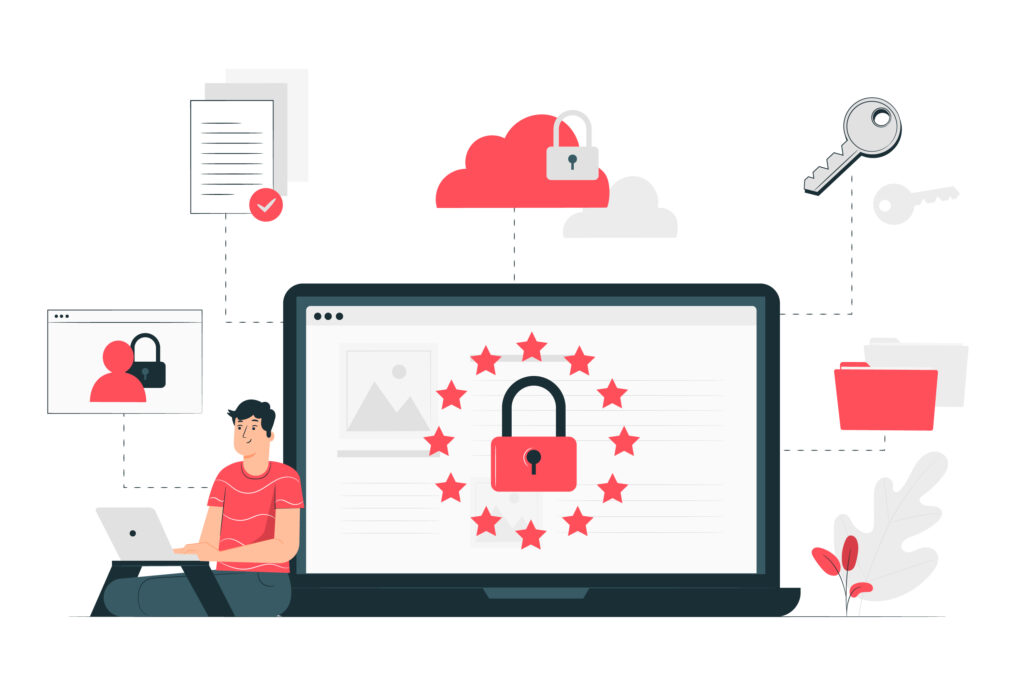The phrases “data privacy” and “data security” have grown in popularity, but do you know what they mean? With the dawn of the digital era, data has become the new oil and companies are making massive profits by collecting and commodifying it. To reduce data exposure, one must be aware of how and where the data is collected.
What Can Happen to Data?
If data privacy and security are not maintained, the data may end up in the wrong hands. It might become part of a public data leak or cybercriminals might weaponize or sell it on the dark web to the highest bidder.
If you own a business, the data might get up in the hands of a competitor, leaking confidential information such as trade secrets, employee data, or customer data. The data breach would not only impact your business financially but also bring negative publicity and reduce goodwill.
Data Privacy
Data privacy refers to who has access or how a piece of information should be handled based on its significance. It is the branch of data management concerned with the processing of personal data in accordance with data protection laws, regulations, and general privacy best practices.
Setting access restrictions to secure information from unauthorised parties, obtaining agreement from data subjects where appropriate, and preserving data integrity are all part of ensuring data privacy.
For example, when introducing oneself, sharing first names is common. But other details such as a date of birth, mobile number or a place of residence would require some mutual trust since it is considered to be personal.
Individuals
The notion of data privacy is applied to crucial personal information, also known as personally identifiable information (PII) and personal health information (PHI). This includes Social Security numbers, health and medical records, financial data such as bank account and credit card details, and even basic but sensitive information such as complete names, residences, and birthdates.
Legal Entities
In a company, data privacy also includes information that helps the firm run, such as exclusive research and development data or financial data that reveals how the company spends and invests its money.
For that reason, when requested to share personal information beyond a first name while opening a bank account, it can be assured to be treated with strict secrecy since financial institutions are required by law to protect and secure their customers’ personal information.
Types of Data
Personal Identifiable Information (PII) – According to the GDPR, any data that can be used to uniquely identify a person such as a full name, mailing address, email address, and phone numbers has historically been deemed personally identifiable information. As technology has advanced, its scope has been increased to IP addresses, login ID details, social media posts and digital images, as well as geolocation, behavioral and biometric data.
Protected Health Information (PHI) – The Health Insurance Portability and Accountability Act (HIPAA) governs protected health information (PHI). Some of its components are as follows:
- An individual’s physical or mental health or condition in the past, present, or future.
- An entity who provides health care to the individual (for example, hospital or doctor).
- Payment for the individual’s health care in the past, present, or future.
Personal Financial Information (PFI) – This includes information about a person’s investments, credit status, loans, liens, wages, and taxes.
Data Security
Data security is concerned with safeguarding personal information from unauthorised third-party access, harmful cyberattacks, and data exploitation. It is designed to secure data by employing various methods and strategies to maintain data privacy.
It incorporates all aspects of information security, such as physical security of hardware and storage devices, administrative and access controls, software security, policies and procedures, and so on.
Data security maintains data integrity, which means that data is accurate, reliable, and accessible to authorised parties. To preserve data security, you may also employ third-party data security solutions such as Bitdefender, Norton Security, and others to provide real-time malware prevention and removal, as well as identity theft protection and endpoint security.
Types of Data Security Controls
- Encryption – Encryption scrambles data by using an algorithm to convert regular text characters into an unreadable format. Only authorised users can read the data with the help of an encryption key. File and database encryption solutions protect sensitive volumes by disguising their contents using encryption or tokenization.
- Data Erasure – This method validates that the deleted data is irrecoverable since it totally overwrites the data on the storage device rather than wiping it.
- Data Masking – Organizations can allow teams to create apps or teach individuals using actual data by masking data. It conceals personally identifiable information (PII) wherever needed so that development can take place in a compliant environment.
- Data Resiliency – The capacity of an organisation to recover from any sort of failure – from hardware issues to power outages and other events that influence data availability – determines its resilience. The rate of recovery is crucial for minimising the effect.
Importance of Data Privacy and Security
When data that should be kept private, such as financial information, healthcare information, and other personally identifiable customer or user data, enters the wrong hands, individuals are at risk of fraud and identity theft.
A breach at a firm can put sensitive data in the hands of a competitor, whereas a breach at an educational facility can put student information in the hands of people who can conduct identity theft. If the breach occurs at the government level, it may jeopardise national security.
Organisations use third-party solutions such as ServiceNow, OneTrust, and others to meet compliance standards while also protecting data privacy, security, and ensuring governance.
Data protection is vital for organisations for several reasons:
- Business Asset Management – We live in a data economy, where firms place a high value on gathering, sharing, and analysing data about their customers or users, particularly via social media. Transparency in how organisations acquire consent to store personal data, adhere to privacy rules, and handle data collected is critical to creating confidence with customers who naturally demand privacy as a human right.
- Regulatory Compliance – It may be argued that managing data to guarantee regulatory compliance is even more critical. A company may be required to satisfy legal obligations on how it collects, stores, and processes personal data, and failure to do so might result in a hefty punishment.
For example, the EU enforced GDPR (General Data Protection Regulation) to strengthen data protection rights for individuals whose personal information come within the scope of its application. It imposes new standards and responsibilities on companies that manage personal data, while also granting consumers broad rights.
Conclusion
Data Privacy and Data Security has a significant distinction. Data security refers to all of the precautions, procedures, and technology put in place to secure data from external and internal risks. However, implementing data security measures alone may not always meet data privacy obligations. Data privacy still necessitates adherence to regulations and compliance governing how data is gathered, shared, and utilised by businesses.
Individually, you should review the privacy settings on your social media accounts on a frequent basis. If you don’t, you may be revealing much more than your name with individuals you’ve never met, and a skilled thief may use that information to steal your identity and much more.
Authored by Animesh Tarodia
Featured image by slidesgo / Freepik

